AMD Launches Excavator Based R-Series APUs for Embedded with DDR4 Support
by Ian Cutress on October 21, 2015 9:00 AM EST
Despite the recent news surrounding AMDs reorganization and financials, today AMD is announcing the launch of its first DDR4 processors. But rather than aiming at the high end or the consumer platforms like their blue competitors, AMDs focus for DDR4 starts in the embedded sector which comprises of digital signage, vertical markets (medical), networking, point-of-sale, commercial and industrial applications.
The new R-series line uses the same Excavator cores we have seen in AMDs Carrizo platform but with an extra level of validation and support. An embedded platform regularly requires security, and thus features such as AMDs use of ARM TrustZone along with high performance graphics and HSA 1.0 features are all aimed at these markets. Currently at launch, AMD is submitting the processors for 'HSA 1.0 Full' validation to the HSA Foundation, and expect to be approved within a week or two.
The initial launch will be of five ‘Merlin Falcon’ processors, supporting DDR3 and DDR4 through a dual controller design, with the single module cheaper silicon being limited on memory speeds. Three of these will be APUs with 3rd generation GCN graphics while two are pure CPU silicon. There will be another set of processors coming in Q1 in the R-series as part of the iTemp line, featuring a wider validated temperature operating window from -40ºC to 105ºC. This will essentially the same silicon as the others, but requires additional validation on AMDs side. Customers requiring ISO or MIL validation will have to enquire with AMD direct.
Obviously an interesting element is the DDR4 support. These are the same silicon as the laptop versions of Carrizo, which doesn't have DDR4 support and begs the question of where it went for consumers. We were told by AMD that for this platform, which is expected to have a 7-10+ year life cycle, the requirements for DDR4 were to allow their customers through the memory transition as the market shifts. Reasons as to why the Carrizo silicon in laptops are not DDR4 enabled revolve around the mix of DDR3-only Carrizo-L and Carrizo designs, as well as marketing of those parts.
Aside from this, the new R-series brings the chipset/south bridge normally connected to provide the storage and PCIe supported onto the same silicon die as the APU. This means that the chipset is now made at the same processing node as the APU, reducing power, but it also makes power management easier as well as reducing the size of the motherboard needed for the system. AMD told us in a briefing that a number of customers have requested an overall smaller form factor for their designs, and this is here for that.
At the time of writing, the new R-series will support three displays, using a variety of connectivity. We have been told that this is the currently validated list, and other display configurations are still being tested. On the left is AMD’s ‘Bald Eagle’ platform, with R-series processors derived from Kaveri cores.
Part of today's announcement also lot to do with the Linux ecosystem surrounding the embedded market. AMD is moving its entire graphics driver stack to open source, removing the disconnect with some closed source drivers. Elements of the stack are under different open source licenses, but it allows customers to develop and distribute a custom driver kernel specific to their needs. Customers can also select part of AMDs Linux distribution platform.
Performance for the new Merlin Falcon parts, according to AMD and running benchmarks such as 3D Mark, puts the high frequency RX-421BD APU at 15W on par with the previous generations RX-427BB (Bald Eagle, Kaveri-based) when at 35W. Customers for these parts can work with AMD and Sapphire (AMD’s long term AMD Pro partner) to obtain evaluation ‘AMD Gardenia’ motherboards.
Just to be clear with these embedded parts, in AMD’s briefing to us they identified the markets they are targeting – gaming machines (poker, pachinko, etc), communication infrastructure, industrial control/automation, storage, medical, security/surveillance and retail signage. Any hopes of being able to play with DDR4 on an Excavator based platform, for the end user at least, is still an unknown. That being said, we are working with AMD to perhaps get a couple of evaluation boards to test, at least to see how DDR3 vs. DDR4 performance comes into the equation.
Source: AMD


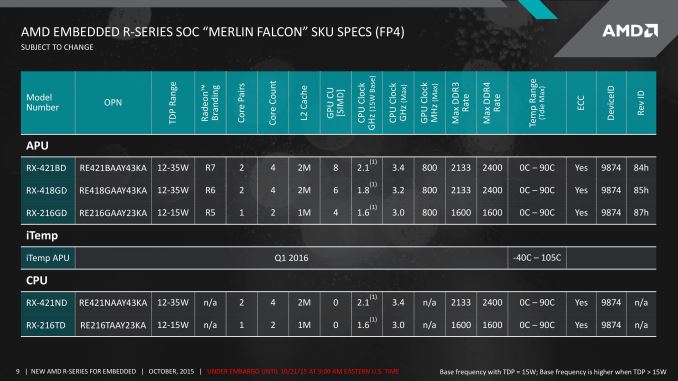
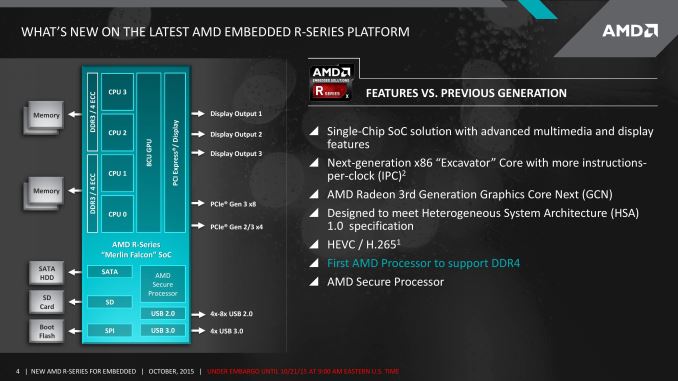
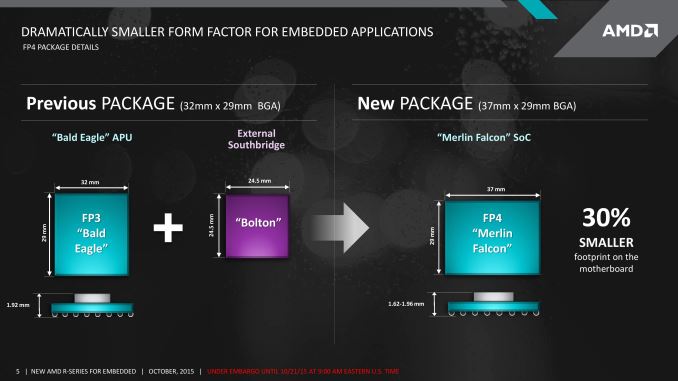
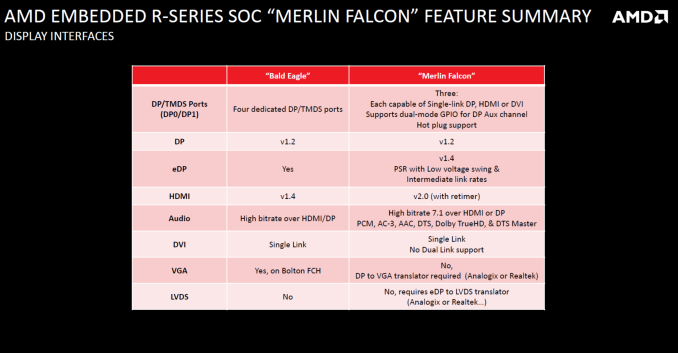
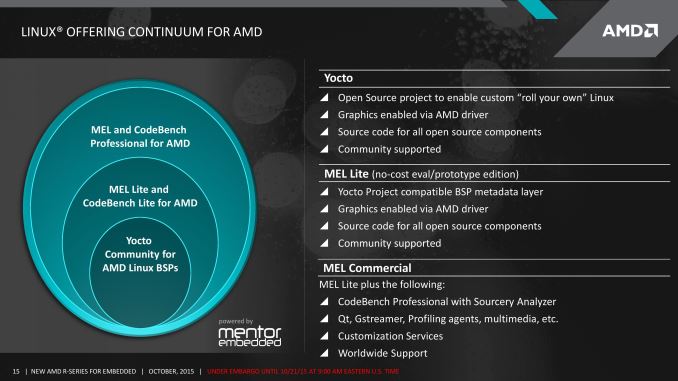
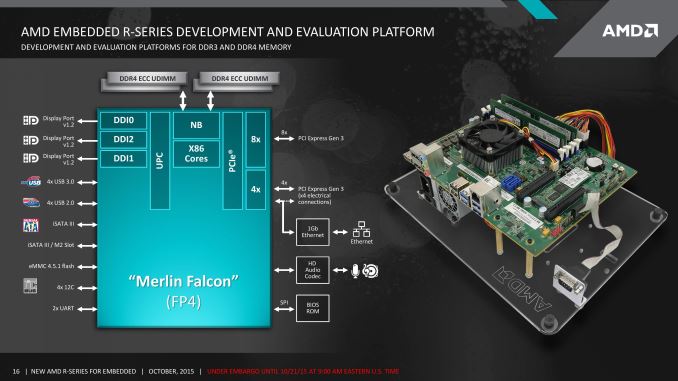














34 Comments
View All Comments
Alexvrb - Thursday, October 22, 2015 - link
HP has some models configured with the FX-8800P or A12 equivalent. I'd bet at least some of the larger more expensive models are 35W. But the default RAM configs will no doubt be screwed up and result in single channel operation, crippling the memory bandwidth. They like to pack in stupid uneven or single stick configs to save a few bucks at each RAM capacity tier.Flunk - Tuesday, November 3, 2015 - link
That manufacturers don't want to send out samples is generally not a good sign.DrMrLordX - Wednesday, October 21, 2015 - link
If you want benchmarks of Carrizo, The Stilt provided some over on the OCN forums:http://www.overclock.net/t/1560230/jagatreview-han...
It's a big thread, but there's some good data in there, especially the fp benchmarks at static clockspeeds. tl;dr: it has ~11% better IPC than Kaveri in fp benchmarks, though it was only 5% faster on Cinebench R10.
The downside is that voltage/clockspeed scaling is inferior for Carrizo vs. GV-A1 Kaveri past 2.6 GHz. It really isn't a logical choice for a desktop CPU unless AMD has done something to the R-series (new stepping?) to improve that situation, at least not with Kaveri out there already. Unless you simply must have GCN 1.2 in an iGPU, then it's Carrizo or bust.
BurntMyBacon - Thursday, October 22, 2015 - link
@DrMrLordX : "The downside is that voltage/clockspeed scaling is inferior for Carrizo vs. GV-A1 Kaveri past 2.6 GHz. It really isn't a logical choice for a desktop CPU ..."Not surprising. AMD stated at launch that Carrizo was superior at low power, but not at higher power. I'm pretty sure they had a chart that showed the crossover point was about 20W. Probably why you see so many 15W systems out there. Thanks for the links.
silverblue - Thursday, October 22, 2015 - link
20W per module I believe as opposed to 20W for the entire APU.With the CPU cores running at 40W total, Carrizo would still be a little faster than Kaveri, but without knowing how much power the GPU portion would use, there's little chance of working out what TDP such a chip would have. Even so, for a 45W Carrizo, it should handily beat the A8-7600 in at least 45W mode. Carrizo was meant to top out at 65W, incidentally.
Alexvrb - Thursday, October 22, 2015 - link
Their embedded solutions are generally low-power like their mobile solutions anyway. So just like in mobile, Carrizo beats Kaveri for the R-series, takes up less mainboard real estate, and has access to DDR4 for additional memory bandwidth and future RAM cost/supply concerns.On the desktop, it doesn't make as much sense and I doubt they will release anything built on Excavator for the desktop. If they do, it would probably be in the 45W range, 65W max. As Silverblue points out I think that would do better than the existing 45W-capable models. Could make for a nice low power HTPC with no dGPU required.
I would like to see them release new steppings of Kaveri for FM2+ between now and Zen (especially for a good overclocking Athlon K). Zen is a long way off and it's been very boring on the desktop front.
albert89 - Monday, November 2, 2015 - link
You may have a point. Anandtech are scared they might find that AMD's Carrizo chip to be a really good APU.przemo_li - Wednesday, October 21, 2015 - link
"we are working with AMD to perhaps get a couple of evaluation boards to test, at least to see how DDR3 vs. DDR4 performance comes into the equation.
"
Please do! Especially for APU as all previous APUs benefited from bigger bandwidth.
ImSpartacus - Wednesday, October 21, 2015 - link
I know! I'm cumming buckets just thinking of what carrizo's biggest gpu might be able to do with some high clocked ddr4.TallestJon96 - Wednesday, October 21, 2015 - link
Good first move to DDR4. Next will be zen with DDR4, then maybe even the AMD built Xbox one will go to DDR4.DDR4 is pretty reasonable to get now. You can get 16gb for $100 or less, and there is a basic 32gb kit that's about $175